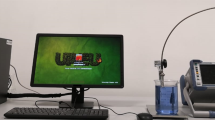Abstract
Extensive literatures have shown significant trend of progressive electrical changes according to the proliferative characteristics of breast epithelial cells. Physiologists also further postulated that malignant transformation resulted from sustained depolarization and a failure of the cell to repolarize after cell division, making the area where cancer develops relatively depolarized when compared to their non-dividing or resting counterparts. In this paper, we present a new approach, the Biofield Diagnostic System (BDS), which might have the potential to augment the process of diagnosing breast cancer. This technique was based on the efficacy of analysing skin surface electrical potentials for the differential diagnosis of breast abnormalities. We developed a female breast model, which was close to the actual, by considering the breast as a hemisphere in supine condition with various layers of unequal thickness. Isotropic homogeneous conductivity was assigned to each of these compartments and the volume conductor problem was solved using finite element method to determine the potential distribution developed due to a dipole source. Furthermore, four important parameters were identified and analysis of variance (ANOVA, Yates’ method) was performed using 2n design (n = number of parameters, 4). The effect and importance of these parameters were analysed. The Taguchi method was further used to optimise the parameters in order to ensure that the signal from the tumour is maximum as compared to the noise from other factors. The Taguchi method used proved that probes’ source strength, tumour size and location of tumours have great effect on the surface potential field. For best results on the breast surface, while having the biggest possible tumour size, low amplitudes of current should be applied nearest to the breast surface.





Similar content being viewed by others
Notes
There is another commercial product that uses a similar arrangement of electrodes and compares the load impedances bilaterally (Z-tech, Inc. [22]) for breast cancer screening, particularly some of the instrumentation developments. There are also groups working with planar arrays of electrodes instruments, some of which are currently undergoing clinical trials (T-scan [20], for example).
An iterative linear algorithm for unsymmetric problems.
Once tumour grows in size, there is a possibility of necrosis and this might alter the tumour conductivity. This is because the metabolic rate and tumour doubling time changes. However, it takes years for a tumour to grow for older subjects in particular (it behaves as a progressive and heterogeneous disease), and the earliest possible indication of abnormality is needed to allow for the earliest possible treatment and intervention.
References
Chaudhary SS, Mishra RK, Swarup A, Thomas JM (1984) Dielectric properties of normal and malignant human breast tissues at radiowave and microwave frequencies. Indian J Biochem Biophys 21:76–79
Cuzick J, Holland R, Barth V, Davies R, Faupel M, Fentiman I, Frischbier HJ, LaMarque JL, Merson M, Sacchini V, Vanel D, Veronesi U (1998) Electropotential measurements as a new diagnostic modality for breast cancer. Lancet 352:359–363
FEMLAB Software. http://www.comsol.com/products/femlab/ (assessed 26 July 2005)
Fricke H, Morse S (1926) The Electric capacity of tumors of the breast. J Cancer Res 16:310–376
Huigen E, Peper A, Grimbergen CA (2002) Investigation into the origin of the noise of surface electrodes. Biol Eng Comput 40(3):332–338
Joines WT, Zhang Y, Li C, Jirtle RL (1994) The measured electrical properties of normal and malignant human from 50 to 900 MHz. Med Phys 21:547–550
Jossinet J, Schnitt M (1999) A review of parameters for the bioelectrical characterization of breast tissue. Ann NY Acad Sci 873:30–34
Modre R, Tilg B, Fischer G, Hanser F, Messnarz B, Seger M, Hintringer F, Roithinger FX (2004) Ventricular surface activation time imaging from electrocardiogram mapping data. Med Biol Eng Comput 42(2):146–150
Morimoto T, Kimura S, Konishi Y, Komaki K, Uyama T, Monden Y, Kinouchi Y, Iritani T (1993) A study of the electrical bio-impedance of tumors. J Invest Surg 6:25–32
Natrella MG (1996) Experimental statistics. Revised edition Wiley, New York
Ng EYK, Sudharsan NM (2001) An improved 3-D direct numerical modeling and thermal analysis of a female breast with tumour. Int J Eng Med Proc IME Part H 215(1):25–37
Ng WK, Ng EYK, Ang WT, Lim J (2004) Simulation of biofield potential for early detection of breast tumor with a realistic female model and artificially inserted carcinoma. In: Proceedings of the international conference on biomedical engineering, Kuala Lumpur, Malaysia, 2–4 September 2004, pp 229–232
Ng EYK, Ng WK, Ang WT, Sim LSJ, Rajendra Acharya U (2005) Modelling of biofield potential for early detection of breast tumor with FEM. Comput Methods Programs Biomed (in press)
Roache PJ (1994) Perspective: a method for uniform reporting of grid refinement studies. ASME J Fluids Eng 116:405–413
Romrell LJ, Bland KI (1991) Anatomy of breast, axilla, chest wall, and related metastatic sites. In: Bland KI, Copeland EM III (eds) The breast: a comprehensive management of benign and malignant diseases. Saunders, Philadelphia, p 22
Sacchini V (1996) Report of the European School of Oncology Task Force on electropotentials in the clinical assessment of neoplasia. Breast 5:282–286
Surowiec AJ, Stuchly SS, Barr JR, Swarup A (1988) Dielectric properties of breast carcinoma and the surrounding tissues. IEEE Trans Biomed Eng 35:257–263
Taguchi G (1986) Introduction to quality engineering. Asian Productivity Organization/UNIPUB, White Plains
The Yale Medical School. http://www.info.med.yale.edu/intmed/cardio/imaging/anatomy/breast_anatomy/ (assessed 26 July 2005)
T-scan Breast Imaging. http://www.imaginis.com/t-scan/ (assessed 26 September 2005)
Weiss BA, Ganepola GAP, Freeman HP, Hsu YS, Faupel ML (1994) Surface electric potentials as a new modality in the diagnosis of breast lesions—a preliminary report. Breast Dis 7:91–98
Z-Tech, Inc. http://www.z-techinc.com/how.html (assessed 26 September 2005)
Acknowledgements
The authors would like to express their appreciation to Dr. J. Cuzick of Biofield Corp., Alpharetta, USA, for sharing his views and interests on “The breast cancer diagnostic system”.
Author information
Authors and Affiliations
Corresponding author
Rights and permissions
About this article
Cite this article
Ng, E.Y.K., Ng, W.K. Parametric study of the biopotential equation for breast tumour identification using ANOVA and Taguchi method. Med Bio Eng Comput 44, 131–139 (2006). https://doi.org/10.1007/s11517-005-0006-0
Received:
Accepted:
Published:
Issue Date:
DOI: https://doi.org/10.1007/s11517-005-0006-0




